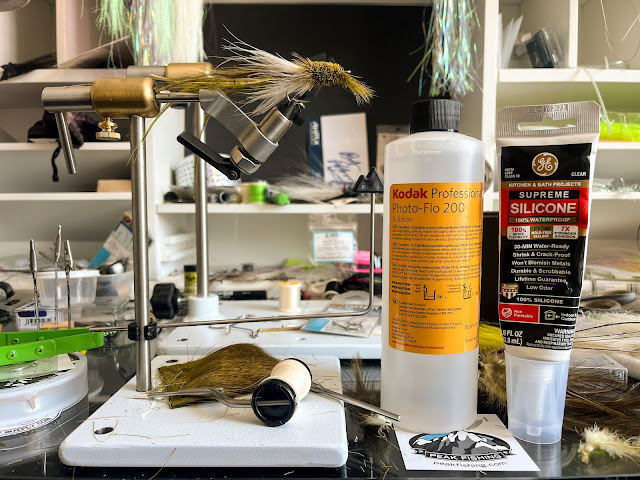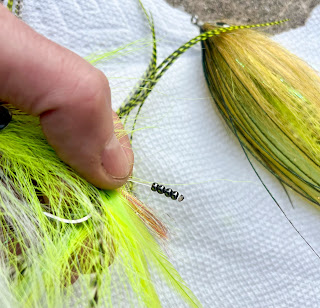Compared to this time last year I am way behind the 8-ball. By February I had a bunch of flies tied up for the spring season, most of them larger herring and bunker style flies. Sitting down now I've struggled to find my fly tying mo-jo, or whatever you might call it. But I did get lucky with above fly and I'll share that story with you.
At this years fly fishing show I spent some time at the Squimpish booth. One of the things I have enjoyed playing around with are David Nelson's Big Fly Brushes. If you look at the above image you can see them hanging just to the right of the Squimpish poster. Before I left I grabbed one of them and this weekend spun one around a hook, an Ahrex A270 Bluewater 6/0.
I wanted to see if I could get away with just tying with the brush, no bucktail base, no hackles off the back. It may look a little intimidating but once you fiddle around with big brushes, and take control of them, it's not that hard to pull off. Some may say to pre-cut the brush but I have found that at times I'm
either too short or too long. Keeping it whole lets me cut to the desired length, saving on any waste. It's basically two ties. One about mid-shank and the other at the head. I'll call this a "Four Turn Brush Fly", not that it needs a name and something that has been tied up way before I gave it a shot.
It is literally that simple. Two turns in the back and two turns in the front. Add some eyes and it's all done. This fly hasn't been trimmed nor ran under the faucet. The only thing I might do to give it a
little body is give it the Steve Farrar Plasti-Dip technique. It's just brushing through a little goo here and there with a bodkin. The fly comes in just under 10 inches and has some bulk up front and a good taper.
I prefer the synthetics because as you can see I'm all thumbs when it comes to tying up Beast Fleyes. I'm looking forward to getting Ru Harvey's "Beast Chest Cones" and giving them a go.
It's just that me and bucktail, outside of a little off the back of a fly, don't have a great relationship. Deer belly hair I do good with it's just those tapers and that thread dam that lies in front that's a killer to me. And of course, over the years I have been guided by the best of them, Buzzi, Taylor and Popovic's on what to look for when choosing and tying with bucktail. I have also come to learn that those thick hollow strands of bucktail don't work well when reversed tied in Hollow style fashion. The below BuzFly tail worked well for me this weekend.
I then moved on to going through some of my fly casualties from last year. Over the years, well not until last year, did I learn the difference between just hooks and good hooks. Most of the flies I tied up last year were on Mustad's or Partridge hooks. Don't get me wrong I've caught fish, and some good fish, on both, but, they aren't as hardy as I'd like. The Mustad's eventually break, and the Partridge's either rust
out or straighten out, and that's when it hurts. When I showed Andrew from Orvis my flies last year he was like, "What hooks are you using?". Then I started to really learn about the gap, and the strength, and the engineering
that goes into a sharp hook tip. Dull hooks mean lost fish. So I have spent my money on upgraded hooks and now spend my money on Ahrex. Not cheap, but you get what you pay for.
I had a few flies that still had a lot of usable Squimpish material on them and I needed to find my fly tying muscle memory so they would do just fine. Plus it would allow me to dissect the flies and see if I would tie them in any different way. In the end I did two over and the yellow one was a fish killer this
past fall. Again, Andrew with solid knowledge told me at last years fly fishing show while we picked through Brad Buzzi's bucktails, "Yellow is such a Jersey color", and he was right.
I then moved to my early spring favorite micro-baits, the mummichogs. I have a simple pattern I did well with last spring but wanted to add a little twist, no pun intended, to them. I like, well love, Snake Flies, and I have seen spun deer hair used on smaller patterns, so there we go. I tied up a half a dozen all a little different, but basically the same kind of fly. I use a slow sinking line so they get down lower than where that spun hair wants to ride in the water column. These are more for the back bays and rivers
where killies are a prevalent bait early in the season. The bass wake up from a long winters nap to eat them. At the show people were asking me what kind of vice I'm tying on these days.
I moved away from the fleet and Regal, hey they make a great vice, and went to Peak. It's a solid line of vices for the beginner to the more advanced tyer. I now have two, a smaller rotary vice, PRV-G2, for normal sized flies and an LIRS (Large Iron Retention System), model JS2-G2, for the 4/0 and larger flies. That vice is also great when spinning hair for Snake Flies, it just doesn't move. And the 10 pound base helps as well. The LIRS is perfect for those big Ahrex Bluewater, Popovics and Clouser hooks, which are thicker in diameter.
Some how the wife just let me be so I continued at it. Hey, why not try some Popovic's Pop Lips? I was feeling like I had a little swagger going and how hard could they be? I've seen some guys I know tie them so why not me?
Well, because they ain't easy. Like everything else there's a learning curve and it made me appreciate Popovic's even more. I deviated, first mistake, away from the fleece collar and tried
using deer hair. My fly would have a simple Snake Fly type head so I just turned the bottom tie around figuring deer hair is stronger than fleece. Mistake #2. As Bob told me, "Fibers are linear whereas fleece is not. Holds together much better." I had the book open so why not just follow it? For the second attempt I did go with
fleece for the collar. I applied the silicone and then used Photo-Flo as directed to smooth it down. In the end I trimmed them up to much and really didn't even have any curve to the lip in order to get that
swimming back and forth motion I was looking for. And to be honest, I had to apply some goop and hit it with the light as it just wasn't strong enough. During the swim test the flies swam like they were
hit over the head, suffered some type of medical episode, and appeared near death. Now, that may just what we need a fly to look like in the water. The lips do make it dive though, and the deer hair head makes it float back to the surface. So, in the end, it wasn't a fail altogether.
I have tied up and have been fishing some big flies for big bass in waters unknown. While they may look more like musky flies the bigger and uglier they are get the job done. While at the Stock the Box
weekend in Newport in January I met local tyer Andre Corvi who had a good way to add some weight, and noise, to his flies. He hangs mono off the back and stacks up some tungsten beads. If you move the fly back and forth you can hear the rattle-like sound the beads make. They say noise travels further and louder underwater so maybe he's onto something. A match flares out the mono as a stop for the beads.
So by the end of Monday I had a nice big brush fly, five of the six mummichogs I tied, I lost the 6th, a few redo's, and two piss-poor Pop Lips for the effort. I have to get back into the groove with the larger baitfish patterns, and soon, opening day is only 264 hours away.




























